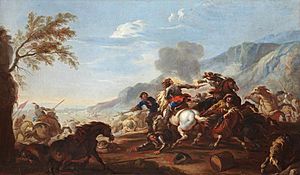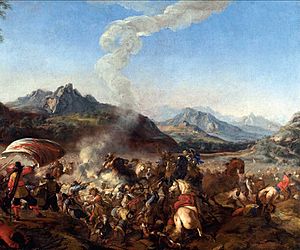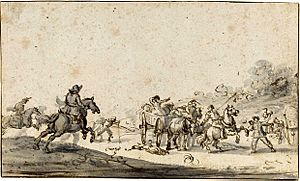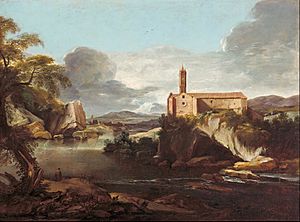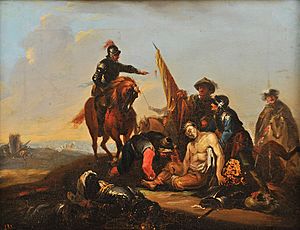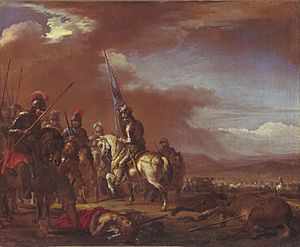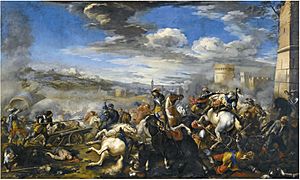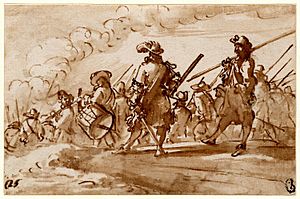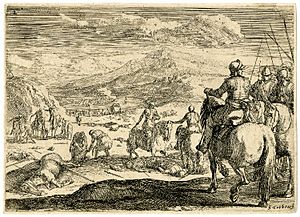Jacques Courtois facts for kids
Jacques Courtois (born around December 1621, died November 14, 1676) was a famous painter from a region called Franche-Comté, which is now part of France. He was also known as Giacomo Cortese. People often called him il Borgognone or le Bourguignon because of where he came from.
Courtois was a talented artist who painted, drew, and made etchings. He spent most of his career in Italy, especially in Rome and Florence. He became very well-known as the best painter of battle scenes during his time. He also created paintings about history and made portraits of people. Later in his life, he joined the Jesuit order, a religious group, but he kept painting.
Contents
Life of Jacques Courtois, the Painter
Jacques Courtois was born in a town called Saint-Hippolyte, near Besançon. This area, Franche-Comté, was part of the Holy Roman Empire back then. His father, Jean-Pierre Courtois, was also a painter, but not very famous. Jacques likely learned to paint from his father.
He had two younger brothers, Guillaume and Jean-François, who also became painters. Sometimes, people confuse their artworks because Guillaume was also called 'il Borgognone'. This nickname referred to their home region of Burgundy.
Early Travels and Army Experience
Around 1636, when Jacques and his brothers were still young, their father took them to Italy. They first went to the city of Milan. For about three years, Jacques served in the Spanish army. During this time, he drew many scenes of marches, battles, and soldiers. This experience helped him become a great battle painter later on.
After leaving the army, he studied in Milan with a sculptor. In 1639, he moved to Bologna and joined the studio of Jérôme Colomès. Famous painters like Guido Reni and Francesco Albani noticed his talent. He continued his training in Siena, studying with Astolfo Petrazzi.
Jacques and his brother Guillaume might have stayed together until the late 1640s. Jacques briefly visited Florence, where he met two other artists. One was Jan Asselijn, who also painted battle scenes. The other was Matthieu van Plattenberg, a marine artist.
Life in Rome and Marriage
Around 1639 or 1640, Jacques Courtois moved to Rome. He lived in a monastery and received his first big art jobs there. One of these was a large painting of the miracle of the loaves and fishes in 1641.
In Rome, he became friends with Pieter van Laer, a Dutch painter. Van Laer was known for his everyday scenes, called Bambocciate. These paintings showed ordinary life in Rome. Michelangelo Cerquozzi, a leading battle painter, saw Courtois's skill. He encouraged Jacques to focus on painting battle scenes.
By the mid-1640s, important Roman families, like the Sacchetti and Chigi, began to support Courtois. Another famous painter, Pietro da Cortona, introduced him to these wealthy patrons. Courtois also painted for people outside Rome, even in Spain.
In 1647, Jacques Courtois married Anna Maria Vaiani in Rome. She was also a painter and engraver. However, their marriage did not last, and they soon separated. When Courtois left Rome for Siena, his wife did not go with him. He worked for Prince Mattias de' Medici, who tried to help the couple get back together, but it didn't work.
Later Life and Religious Path
After his wife died in 1654, Jacques Courtois helped manage his family's affairs. He also painted religious pictures for a convent where his sisters were nuns.
He spent time in Bergamo, Italy, and painted an altarpiece there in 1656. He met other artists and art dealers in Bergamo. Later, he traveled to Venice at the invitation of Nicolò Sagredo, a Venetian ambassador. Sagredo asked Courtois to paint scenes in the famous St. Mark's church.
After passing through Padua and Bologna, Courtois returned to Florence in 1656. He worked again for Prince Mattias de' Medici. In 1657, he went back to Rome and joined the Jesuit order. Even as a Jesuit, he continued to paint. He created religious artworks, but also returned to his favorite subject: warfare. He started signing his drawings with a cross.
In 1668, he became a priest. He received important jobs to paint frescoes in the Church of the Gesù, a main Jesuit church in Rome. He was still working on this project when he died in Rome on November 14, 1676.
Artistic Works of Jacques Courtois
Jacques Courtois is best known for his exciting battle scenes. But he also painted religious pictures and peaceful landscapes. His religious works showed the influence of Pietro da Cortona, with whom he had worked. He also painted a few portraits, including one of his supporter, Prince Mattias de' Medici, and a self-portrait.
Battle Paintings
Courtois painted both imaginary battles and real ones from the Thirty Years' War. He had seen war firsthand, which helped him make his paintings look very real. People called him the 'Raphael of battles' and the 'Prince Eugene of painters'. Prince Eugene was a very successful military leader.
Courtois's battle paintings were so popular that almost every art collection had one. He made viewers feel like they were right in the middle of the fight. In his time, people were proud of their armies' successes. Battle paintings celebrated victories, but also showed the drama of war. They showed brave actions and the harsh results for soldiers. Courtois used all his skills to create exciting scenes.
An example of his skill is the painting Battle scene with infantry, cavalry and cannon, a fortress and a city beyond. In this work, Courtois puts the most dramatic part, like soldiers fighting hand-to-hand, right in the front. This pulls the viewer into the action. The painting shows the chaos of battle with many men and horses. The dramatic clouds above add to the powerful feeling of the scene.
Jacques Courtois often painted alla prima, meaning he applied paint quickly without waiting for layers to dry. This fast way of painting matched the energy of his battle scenes.
His early battle scenes were influenced by Michelangelo Cerquozzi, who painted battles and everyday scenes. Courtois's works shared Cerquozzi's interest in small details and storytelling. Later, his style changed after meeting Salvator Rosa in Florence. Rosa's dark, fiery landscapes and battle scenes likely made Courtois use bolder brushstrokes and darker colors.
Drawings and Etchings
Courtois was also a very talented draftsman. His drawings show the freedom and energy of the Baroque art style. His sketchbooks, found in London and Florence, show how quickly he could capture the movement of soldiers. His drawings were influenced by artists like Jacques Callot and Stefano Della Bella.
In 1647, Courtois helped illustrate a book called "De Bello Belgico." This book was about the Spanish wars in Flanders during the 16th century. Courtois created four designs showing the siege and capture of different cities.
Influence on Other Artists
Courtois's art had a big impact on many Italian artists, including Francesco Monti and Francesco Simonini. The French artist Joseph Parrocel was also influenced by him. Geronimo Bruni, an etcher, was one of Courtois's students.
See also
 In Spanish: Jacques Courtois para niños
In Spanish: Jacques Courtois para niños


